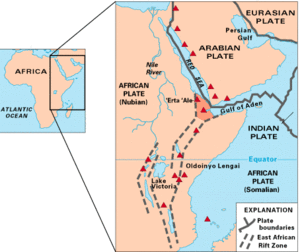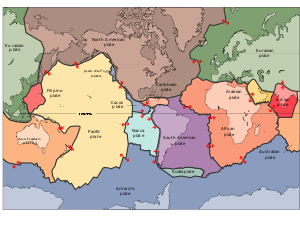- African Plate
-
The African Plate is a tectonic plate which includes the continent of Africa, as well as oceanic crust which lies between the continent and various surrounding ocean ridges.
Contents
Boundaries
The westerly side is a divergent boundary with the North American Plate to the north and the South American Plate to the south forming the central and southern part of the Mid-Atlantic Ridge. The African plate is bounded on the northeast by the Arabian Plate, the southeast by the Indo-Australian Plate, the north by the Eurasian Plate and the Anatolian Plate, and on the south by the Antarctic Plate. All of these are divergent or spreading boundaries with the exception of the northern boundary with the Eurasian Plate (except for a short segment near the Azores, the Terceira Rift).
Components
The African Plate includes several cratons, stable blocks of old crust with deep roots in the subcontinental lithospheric mantle, and less stable terranes, which came together to form the African continent during the assembly of the supercontinent Gondwana around 550 million years ago. The cratons are, from south to north, the Kalahari craton, Congo craton, Tanzania craton and West African craton. The cratons were widely separated in the past, but came together during the Pan-African orogeny and stayed together when Gondwana split up. The cratons are connected by orogenic belts, regions of highly deformed rock where the tectonic plates have engaged. The Saharan Metacraton has been tentatively identified as the remains of a craton that has become detached from the subcontinental lithospheric mantle, but alternatively may consist of a collection of unrelated crustal fragments swept together during the Pan-African orogeny.
In some areas, the cratons are covered by sedimentary basins, such as the Tindouf basin, Taoudeni basin and Congo basin, where the underlying archaic crust is overlaid by more recent Neoproterozoic sediments. The plate includes shear zones such as the Central African Shear Zone (CASZ) where, in the past, two sections of the crust were moving in opposite directions, and rifts such as the Anza trough where the crust was pulled apart, and the resulting depression filled with more modern sediment.
Modern movements
 Map of East Africa showing some of the historically active volcanoes(red triangles) and the Afar Triangle (shaded, center) -- a triple junction where three plates are pulling away from one another: the Arabian Plate, and the two parts of the African Plate (the Nubian Plate and the Somali Plate) splitting along the East African Rift Zone (USGS).
Map of East Africa showing some of the historically active volcanoes(red triangles) and the Afar Triangle (shaded, center) -- a triple junction where three plates are pulling away from one another: the Arabian Plate, and the two parts of the African Plate (the Nubian Plate and the Somali Plate) splitting along the East African Rift Zone (USGS).
The African Plate is rifting in the eastern interior along the East African Rift. This rift zone separates the Nubian Plate to the west from the Somali Plate to the east. One hypothesis proposes the existence of a mantle plume beneath the Afar region, while an opposing hypothesis asserts that the rifting is merely a zone of maximum weakness where the African Plate is deforming as plates to its east are moving rapidly northward.
The African Plate's speed is estimated at around 2.15 cm (0.85 in) per year. It has been moving over the past 100 million years or so in a general northeast direction. This is drawing it closer to the Eurasian Plate, causing subduction where oceanic crust is converging with continental crust (e.g. portions of the central and eastern Mediterranean). In the western Mediterranean, the relative motions of the Eurasian and African plates produce a combination of lateral and compressive forces, concentrated in a zone known as the Azores-Gibraltar Fault Zone. Along its northeast margin, the African Plate is bounded by the Red Sea Rift where the Arabian Plate is moving away from the African Plate.
The New England hotspot in the Atlantic Ocean has probably created a short line of mid to late-Tertiary age seamounts on the African Plate but appears to be currently inactive.[1]
References
External links
- USGS - Understanding plate motions
- Cenozoic dynamics of the African plate with emphasis on the Africa-Eurasia collision
- Huang, Zhen Shao (1997). "Speed of the Continental Plates". The Physics Factbook. http://hypertextbook.com/facts/ZhenHuang.shtml.
Tectonic plates Major 
Minor Other Aegean Sea · Altiplano · Amurian · Anatolian · Apulian · Australian · Balmoral Reef · Banda Sea · Bird's Head · Burma · Capricorn · Caroline · Conway Reef · Easter · Explorer · Falklands · Futuna · Galapagos · Gonâve · Gorda · Greenland · Halmahera · Iberian · Indian · Iranian · Juan Fernández · Kerguelen · Kermadec · Kula · Madagascar · Manus · Maoke · Mariana · Molucca Sea · New Hebrides · Niuafo'ou · North Andes · North Bismarck · North Galapagos · Nubian · Okhotsk · Okinawa · Panama · Pelso · Philippine Mobile Belt · Rivera · Sangihe · Seychelles · Shetland · Solomon Sea · Somali · South Bismarck · South Sandwich · Sri Lanka · Sunda · Timor · Tisza · Tonga · Woodlark · YangtzeAll Major African geological formations Tectonic plates Cratons and Shields Arabian-Nubian Shield · Congo craton · Kaapvaal craton · Kalahari craton · Saharan Metacraton · Tanzania craton · Tuareg Shield · West African craton · Zimbabwe cratonShear zones Aswa Dislocation · Broodkop Shear Zone · Central African Shear Zone · Chuan Shear Zones · Foumban Shear Zone · Mwembeshi Shear Zone · Todi Shear Zone · Western Meseta Shear ZoneRifts Afar Depression · Anza trough · Bahr el Arab rift · Benue Trough · Blue Nile rift · East African Rift · Gulf of Suez Rift · Lamu Embayment · Melut Basin · Muglad Basin · Red Sea Rift · Atbara rift · White Nile riftSedimentary basins Angola Basin · Blue Nile Basin · Chad Basin · Congo Basin · Douala Basin · Foreland Karoo Basin · Gabon Basin · Iullemmeden Basin · Kufra Basin · Murzuq Basin · Niger Delta Basin · Ogaden Basin · Orange River basin · Owambo Basin · Reggane Basin · Rio del Rey Basin · Sirte Basin · Somali Coastal Basin · Taoudeni basin · Tanzania Coastal Basin · Tindouf BasinMountain ranges Aïr Mountains · Atlas Mountains · Aurès Mountains · Bambouk Mountains · Blue Mountains · Cameroon line · Central Pangean Mountains · Chaillu Mountains · Drakensberg · Ethiopian highlands · East African mountains · Great Escarpment · Great Karas Mountains · Guinée forestière · Imatong Mountains · Jebel Uweinat · Loma Mountains · Mandara Mountains · Marrah Mountains · Mitumba Mountains · Nuba Mountains · Rwenzori Mountains · Sankwala Mountains · Serra da Leba · Serra da Chela · Teffedest Mountains · Tibesti MountainsCategories:- Tectonic plates
- Geology of Africa
- Geology of the Atlantic Ocean
- Geology of the Indian Ocean
Wikimedia Foundation. 2010.

